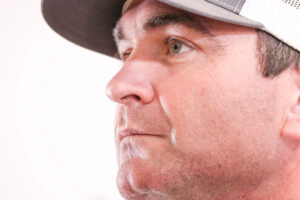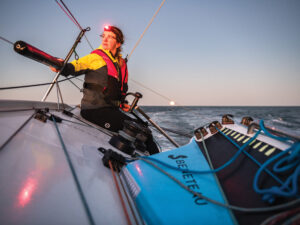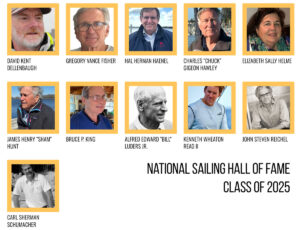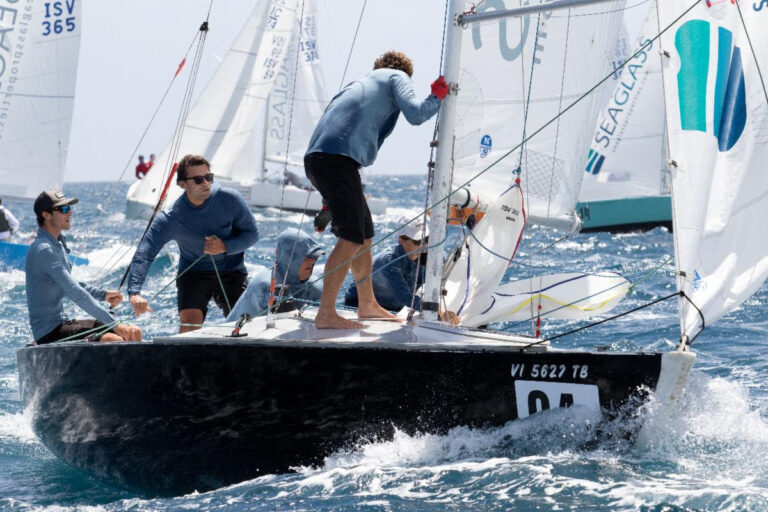
110506_JC_Kitchen
In developing a system which will allow graphic elements to be overlaid onto live video, Stan Honey said that he and his team are not only breaking new ground for the sport of sailing, but for sports coverage in general. As the mind behind the glowing hockey puck, the National Football League’s first down line, and the pop-up info boxes for NASCAR broadcasts, Honey knows more than a little bit about forging new electronic trail.
“The thing that makes it difficult for this sport, is that unlike other sports, where those graphic insertions on cameras on tripods,” said Honey, during a May 6 media briefing on the test events being run by the America’s Cup Event Authority on New Zealand’s Hauraki Gulf. “The beauty of tripods is you know where they are and they stay where you put them, and it’s relatively easy to measure the angle of the camera relative to the tripod. In this system the enormously difficult thing that we’re solving is that the camera is in the helicopter so we have to accurately measure the location of the helicopter and the attitude of the helicopter to have the graphics be in the right place. I think it’s pretty clear that we’re going to be able to make that work. We’ve had some wrinkles and it’s a work in progress, but it was very encouraging yesterday that the fundamental precision of our ability to measure the location and attitude of the helicopter and the location and attitude of the boats can support that application.”
Gary Lovejoy, the Director of America’s Cup TV, was equally pleased with the initial efforts of his team. “We plugged it in and it played,” said Lovejoy. “That goes for all of the different elements we want to bring to our coverage.
John Craig, the PRO for AC34, wasn’t as positive. Craig’s focus has been on creating and identifying the arena where the boats will sail and creating course configurations that generate exciting racing. Ironically, with all the technology that will go into defining the virtual boundaries of the racecourse, determining things like OCS starts, and regulating the competition time down to the second so the event will be as TV-friendly as possible, what is giving Craig the most trouble is determining the most exciting course.
| Courtesy www.AmericasCup.com |
| **The key decisions are being made largely by umpires viewing the racing from a remote location. Jetski umpires provide an additional viewpoint. Given the speeds of the cats, the old method of following the boats in RIBs wasn’t feasible. Or safe. ** |
“We tried a lot of windward-leewards,” said Craig of the first day of racing. “We’ve tried short windward beats, trying to get the fleet [to the windward mark] at the same time. We’ve done that in, I’ll call it, a match-race format, where we’re having everybody rounding to starboard at the windward mark. In all honesty, that hasn’t been a great success; it’s something that we need to work on. The competitors have all figured out, because it’s such a short beat, that positioning is key and not speed, so there’s been a lot of pinching and going forward to the windward mark in a tactical way rathern than what the boats are designed to do, which is speed around the course. What we’ve learned out of that is we need to come up with some other courses. So for the last two days we’ve pulled some very creative courses out of the bag. Some with reaching starts some with running starts. Really let’s just see what we can do.”
Craig’s honesty is refreshing, and is the best indication so far that ACEA has really been given carte blanche when it comes to re-making the America’s Cup. Combined with Stan Honey’s expertise and the organization’s willingness to look outside the box, both for personnel and ideas, this all bodes well for the new face of sailing’s flagship event.
I still have some concern that ACEA and America’s Cup Race Management are trying too hard to manufacture the perfect race—one with a lot of passing opportunities and the boats kept close together around the track. Too much tinkering with the format may eventually prove counterproductive. The sailors are smart. Their ability to quickly deduce the fastest way around a specific track may keep the race committee on the back foot. This challenge is only made more difficult by the fact that due to the ridiculous speeds of the AC45s (and the AC72s), the apparent wind is always well forward. This all but eliminates one significant advantage a trailing boat had in slower designs, namely the ability to block the wind on downwind legs and use that to close the gap or even make the pass.
Three other interesting tidbit from the press conference:
Doing a 270-degree turn in a catamaran is pain, and in breeze, dangerous. So the penalty system they’ve been employing for fouls is to use Honey’s technology to force the offending boat to drop 4-boatlengths behind the other boat. Like everything, this is a work in progress. But it’s an intriguing solution and one that could prove to be much more equitable than the previous 270-degree turn.
Streaming internet coverage of the America’s Cup World Series events is planned from the first event on. Lovejoy spoke of a four-feed set-up that would allow web viewers to pick the point of view they wanted for any race.
Best quote of the afternoon went to Lovejoy toward the end of the conference, speaking about how serious they are about constraining the field of play and forcing competitors to work within a tight, and often arbitrary box. “Ultimately we want a bear pit. It’s quite a big bear pit in San Francisco. But that’s where you want people to fight. We don’t want this thing spread off across oceans. This is what we want to achieve. It’s all geared to the same thing, which is to reduce it to reduce it to the size of the kind of sporting arena that people are used to watching in greater numbers than sailing.” When was the last time, someone referred to a sailing circle as a “bear pit.” Definitely some outside-the-box thinking going on there.









